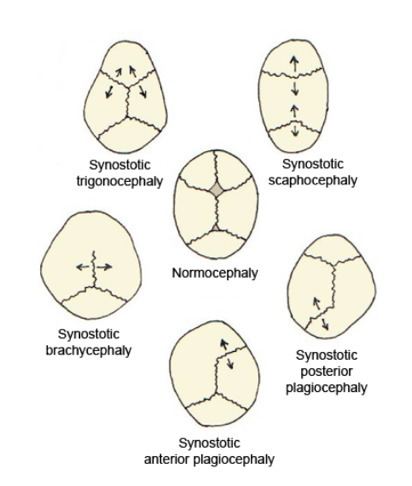Specialty medical genetics ICD-9-CM 754.0 | ICD-10 Q67.3 DiseasesDB 29858 | |
 | ||
Plagiocephaly, also known as flat head syndrome, is a condition characterized by an asymmetrical distortion (flattening of one side) of the skull. It is characterized by a flat spot on the back or one side of the head caused by remaining in a supine position for too long.
Contents
Plagiocephaly is the word that is used to describe a diagonal asymmetry across the head shape. This word particularly describes a flattening which is to one side at the back of the head and there is often some facial asymmetry. Plagiocephaly divides into two groups: synostotic plagiocephaly, with one or more fused cranial sutures, and nonsynostotic (deformational) plagiocephaly. Surgical treatment of these groups includes the deference method; however, the treatment of deformational plagiocephaly is controversial. Brachycephaly describes a very wide head shape with a flattening across the whole back of the head.
Causes
Slight plagiocephaly is routinely diagnosed at birth and may be the result of a restrictive intrauterine environment giving a "diamond" shaped head when seen from above. If there is premature union of skull bones, this is more properly called craniosynostosis.
The incidence of plagiocephaly has increased dramatically since the advent of anti-Sudden Infant Death Syndrome recommendations for parents to keep their babies on their backs.
Data also suggests that the rates of plagiocephaly is higher among twins and multiple births, premature babies, babies who were positioned in the breech position or back-to-back, as well as babies born after a prolonged labour.
Prognosis
Preliminary research indicates that some babies with plagiocephaly may comprise a high-risk group for developmental difficulties. Other research suggests that while developmental delay is more commonplace among babies with plagiocephaly, it cannot be inferred that plagiocephaly is the cause of the delay.
Prevention
Following methods could serve as prevention: carrying the infant and tummy time.
Treatment
The condition may improve to some extent as the baby grows, but in some cases, treatment can improve the shape of a baby’s head.
Repositioning
Initially, treatment usually takes the form of reducing the pressure on the affected area through repositioning of the baby onto their abdomen for extended periods of time throughout the day.
This may include repositioning the child's head throughout the day so that the rounded side of the head is placed dependent against the mattress, repositioning cribs and other areas that infants spend time in so that they will have to look in a different direction to see their parents, or others in the room, repositioning mobiles and other toys for similar reasons, and avoiding extended time sleeping in car-seats (when not in a vehicle), bouncy seats, or other supine seating which is thought to exacerbate the problem. If the child appears to have discomfort or cries when they are repositioned, they may have a problem with the neck.
Helmets
High quality evidence is lacking for cranial remolding orthosis (baby helmet) for the positional condition and use for this purpose is controversial. If conservative treatment is unsuccessful helmets may help to correct abnormal head shapes. These helmets are used to treat deformational plagiocephaly, brachycephaly, scaphocephaly and other head shape deformities in infants 3–18 months of age by gently allowing the head shape to grow back into a normal shape. This type of treatment has been used for severe deformations.
Etymology
Greek plagios "oblique, slanting," from PIE plag- "flat, spread," from *plak, and cephal Modern Latin "head, skull, brain," together means flat head.
